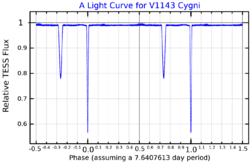Astronomy:HR 7484
| Observation data Equinox J2000.0]] (ICRS) | |
|---|---|
| Constellation | Cygnus |
| Right ascension | 19h 38m 41.18316s[2] |
| Declination | +54° 58′ 25.6420″[2] |
| Apparent magnitude (V) | 5.889±0.015[3] - 6.37[4] |
| Characteristics | |
| Spectral type | F6V[5] (F5 V + F5 V)[3] |
| B−V color index | 0.482±0.004[5] |
| Variable type | Algol[4] |
| Astrometry | |
| Radial velocity (Rv) | −13.9±0.2[5] km/s |
| Proper motion (μ) | RA: +34.885[2] mas/yr Dec.: +162.839[2] mas/yr |
| Parallax (π) | 24.7090 ± 0.0422[2] mas |
| Distance | 132.0 ± 0.2 ly (40.47 ± 0.07 pc) |
| Absolute magnitude (MV) | 2.83[5] |
| Orbit[3] | |
| Period (P) | 7.64075217±0.00000051 d[6] |
| Semi-major axis (a) | 22.6950 astronomical unit|AU |
| Eccentricity (e) | 0.5378±0.0003 |
| Inclination (i) | 87.0±1.0° |
| Argument of periastron (ω) (secondary) | 0.860±0.001° |
| Semi-amplitude (K1) (primary) | 88.02±0.05 km/s |
| Semi-amplitude (K2) (secondary) | 89.97±0.10 km/s |
| Details[3] | |
| V1143 Cyg A | |
| Mass | 1.356±0.003 M☉ |
| Radius | 1.339±0.023 R☉ |
| Luminosity | 2.83±0.2[7] L☉ |
| Surface gravity (log g) | 4.317±0.015 cgs |
| Temperature | 6,450±100 K |
| Metallicity [Fe/H] | 0.08 dex |
| Rotational velocity (v sin i) | 18±3[7] km/s |
| V1143 Cyg B | |
| Mass | 1.328±0.002 M☉ |
| Radius | 1.316±0.023 R☉ |
| Luminosity | 2.65±0.2[7] L☉ |
| Surface gravity (log g) | 4.323±0.015 cgs |
| Temperature | 6,400±100 K |
| Rotational velocity (v sin i) | 28±3[7] km/s |
| Other designations | |
| Database references | |
| SIMBAD | data |
HR 7484 (V1143 Cyg) is a binary star system in the northern constellation of Cygnus. It is dimly visible to the naked eye under good viewing conditions, having an apparent visual magnitude of 5.89.[3] Based upon an annual parallax shift of 24.71,[2] it is located 132 light years away. The system is moving closer with a heliocentric radial velocity of −14 km/s.[5]
Observational history
Radial velocity measurements taken at the Dominion Astrophysical Observatory in Victoria, British Columbia Canada in 1919 led to the determination by William Edmund Harper that HR 7484 is a double-lined spectroscopic binary.[9] The next year he published an orbit with a period of 7.6383 days as compared to the modern value of 7.64075217 days.[10]
Physical characteristics
HR 7484 is a detached eclipsing binary, which means the orbital plane is aligned close to the line-of-sight from the Earth, causing the components to eclipse twice per orbit.[11] The system is undergoing apsidal motion, with a rate greater than that predicted by general relativity.[11] Both components are ordinary F-type main-sequence stars with similar physical properties.[3] The star normally has an apparent magnitude of 5.89, but every 7.64 days (7 days, 15 hours, and 22 minutes) its brightness decreases to magnitude 6.37, approximately two thirds as bright. Five days and 17 hours after each primary eclipse, there is a secondary eclipse when the brightness drops to magnitude 6.06, about 85% of the normal brightness. Each eclipse lasts for 220 minutes.[4] Both eclipses are partial.[7]
References
- ↑ "MAST: Barbara A. Mikulski Archive for Space Telescopes". Space Telescope Science Institute. https://mast.stsci.edu/portal/Mashup/Clients/Mast/Portal.html.
- ↑ 2.0 2.1 2.2 2.3 2.4 2.5 Brown, A. G. A. (August 2018). "Gaia Data Release 2: Summary of the contents and survey properties". Astronomy & Astrophysics 616: A1. doi:10.1051/0004-6361/201833051. Bibcode: 2018A&A...616A...1G. Gaia DR2 record for this source at VizieR.
- ↑ 3.0 3.1 3.2 3.3 3.4 3.5 Graczyk, Dariusz et al. (March 2017). "The Surface Brightness-color Relations Based on Eclipsing Binary Stars: Toward Precision Better than 1% in Angular Diameter Predictions". The Astrophysical Journal 837 (1): 19. doi:10.3847/1538-4357/aa5d56. 7. Bibcode: 2017ApJ...837....7G.
- ↑ 4.0 4.1 4.2 Samus, N. N. et al. (2009). "VizieR Online Data Catalog: General Catalogue of Variable Stars (Samus+ 2007-2013)". VizieR On-line Data Catalog: B/GCVS. Originally Published in: 2009yCat....102025S 1. Bibcode: 2009yCat....102025S.
- ↑ 5.0 5.1 5.2 5.3 5.4 Anderson, E.; Francis, Ch. (2012), "XHIP: An extended hipparcos compilation", Astronomy Letters 38 (5): 331, doi:10.1134/S1063773712050015, Bibcode: 2012AstL...38..331A.
- ↑ Gimenez, A.; Margrave, T. E. (2005). "Relativistic apsidal motion in the eclipsing binary systems V1143 Cygni and EK Cephei". Astronomical Journal 90 (2): 358–363. doi:10.1086/113740. Bibcode: 1985AJ.....90..358G.
- ↑ 7.0 7.1 7.2 7.3 7.4 Anderson, J.; Garcia, J.; Gimenez, A.; Nordstrom, B. (1987). "Absolute dimensions of eclipsing binaries. X - V1143 Cygni". Astronomy & Astrophysics 174: 107–115. Bibcode: 1987A&A...174..107A.
- ↑ "HD 185912". SIMBAD. Centre de données astronomiques de Strasbourg. http://simbad.u-strasbg.fr/simbad/sim-basic?Ident=HD+185912.
- ↑ Plaskett, J. S. et al. (1919). "Fourth list of spectroscopic binaries". Journal of the Royal Astronomical Society of Canada 13: 372–378. Bibcode: 1919JRASC..13..372P.
- ↑ Harper, W. E. (1920). "The orbits of the spectroscopic components of Boss 5026". Astrophysical Journal 51: 187–189. doi:10.1086/142537. Bibcode: 1920ApJ....51..187H.
- ↑ 11.0 11.1 Dariush, A. et al. (April 2005). "Photometric Observations and Apsidal Motion Study of V1143 Cyg". Astrophysics and Space Science 296 (1–4): 141–144. doi:10.1007/s10509-005-4416-0. Bibcode: 2005Ap&SS.296..141D.
 |


